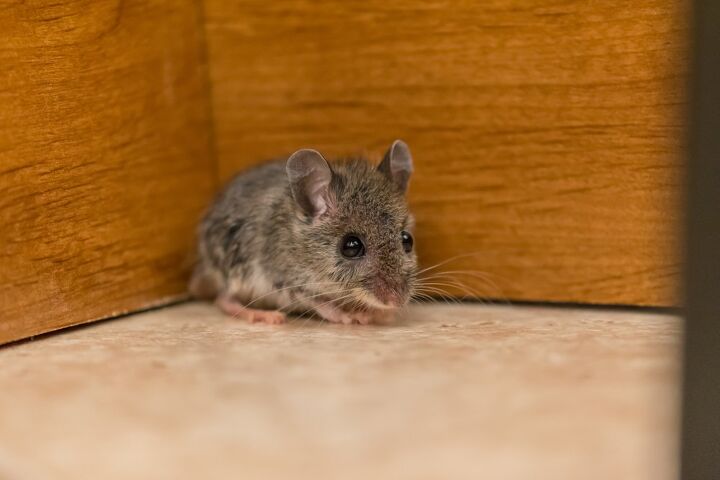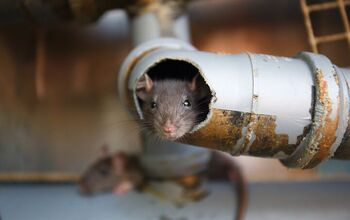Can Mice Climb Stairs? (Find Out Now!)

Mice can be troublemakers and can prove to be a real headache if they are in your home. In dealing with them, you can find they are destructive, and no one likes them in their house. They constantly chew furniture, books, clothing, and electrical wiring, along with other household items.
Mice usually do not go upstairs, but mice can climb stairs with no problem. They have no difficulty climbing stairs, so long as the stairs don’t consist of slippery material. Mice can climb all types of stairs, from wood and tiles to carpet and linoleum.
Most species of mice can jump to a height of about one foot without any fuss. Thus, they can be able to jump up the steps on your staircase to their desired destination. To deal with them, you first have to familiarize yourself with their habits and abilities.
What Are The Different Types Of Mice That Might Be In Your House?
There are two types of mice you may find in your home — field mice and house mice. Each mouse has their own characteristics and ways of making your house their domain. But there is no real difference between the two in their climbing and eating behaviors.
The difference between field and house mice is what they climb and how easily they can do it. Field mice can climb up trees, grass, rock, sand, and fences easily. However, a house mouse may find climbing walls, stairs, and counters easier.
Can Mice Climb Stairs?
Stairs are for climbing, and although mice’s feet are very small, they can still climb stairs. A mouse can climb wood, concrete, or carpeted stairs with speed and stealth. They can run or climb up along the edge of the stairwell on the trim or even climb up on the hand railing.
You really can’t stop mice from climbing stairs because making steps out of slippery material is a hazard. It doesn’t matter whether it’s indoors or outdoor stairs; mice can climb it all. It is not uncommon to see mice climb or jump your stairs to get where they want to go.
How Do Mice Climb Stairs?
Mice have tiny feet and claws that can grip many surfaces. Their small claws allow them to latch onto and climb any surface quickly. In addition, mice can use their whiskers to sense whether a surface is smooth or rough.
Mice can also travel across telephone or power lines, as well as wires like skilled tightrope walkers. Additionally, mice can run up to 8 mph, which may not seem like much, but it gets them where they need to go. Their speed is equivalent to an average-sized human being running up to 160 mph.
Their claws and speed certainly explain why they can be so difficult to trap. It is simplistic to call a professional or do preventative care yourself.
How To Deter Mice From Climbing
To deter mice from coming inside, cutting grass and other greenery near your home may eliminate climbing access. Cutting grass and plants will significantly reduce the chance they’ll try to get into your home with ease. Even climbing weeds is possible for their lightweight bodies to reach a hole in your siding.
Eliminating all entry points into your home is key to deterring mice from entering. Covering caulk holes, cover any gaps with boards, or stuff steel wool into a hole. Mice hate steel wool because it hurts their paws and teeth, and they will refuse to enter.
Along with sealing gaps and holes, you need to seal off any open pipes. Also, planting specific plants, such as spearmint, peppermint, lavender, rosemary, and sage, will create a scented barrier.
Mice are agile climbers who never miss a good entry point. When mouse-proofing your building, don’t underestimate mice’s climbing abilities. They could unpleasantly surprise you by showing up on your countertop or inside on your stairs.
What Surfaces Can Mice Climb?
The fact is, the majority of materials in which your home is built are very “climb-able” to mice. It’s impossible to make your home unclimbable for mice. So a possible mouse prevention method is catching them early.
The fact that mice can get into almost anywhere, regardless of the size, is often a hard pill to swallow. They can squeeze into the smallest of areas, which is the size of a dime. If they can push their head through it, the rest of their body will follow.
Poorly sealed windows and doors can be a simple way for the mice to travel upstairs. The plumbing lines in the house also prove to be a place a mouse can move from floor to floor. There are cases of mice coming through the toilet bowls as well.
There are ways you can minimize the chances they’ll be climbing around on your property. A list of materials that they can climb may help you in making a decision on household materials. They can climb anything from any type of wood, stucco, brick, gutters, and vinyl siding.
Can Mice Climb The Stairs To Get In The Attic?
Mice like staying in the attic because they are nocturnal animals, and they prefer dark places. You can often hear them scurrying around in the middle of the night. They love attics because they are cluttered and warm, but how do the mice get into your attic?
They can use the stairs, the walls, or the chimney. Moreover, they can use the gaps, so you should take extra precautions in sealing holes. A mouse can also jump into the attic from surrounding trees.
Air ducts are also notorious for providing the perfect accommodation for mice. Air ducts often connect to different house floors once they are inside. Using your stairs can be the least of your problems if you have mice in your attic.
More Facts About Mice And Their Abilities
With poor eyesight, mice rely on their keen sense of hearing and smell to help them navigate. They use their sensitive whiskers, sense of smell, and ears to find, climb and eat at opportune times. These characteristics also show that mice are actually attracted to certain textures and foods.
Mice are polyestrous, which means they can breed year-round. A female mouse can produce anywhere from 7 to 8 litters a year, with an average of 10 to14 pups. This means if a mouse does climb your stairs and gets in your attic you can have an infestation fairly quickly.
Their ability to adapt to harsh conditions coupled with reproduction in large numbers make mice successful at survival. Watching for signs of mice and preventing them from entering your home, you can be sure to catch them early. No one wants mice on their second floor, let alone hundreds of them scurrying about.
Learning that mice are both adaptable and intelligent, it’s no surprise that scientists use them as the subjects of countless studies. Certain species of mice can also make great house pets. With the collective knowledge we have of mice and other pests you can know how to use preventative care.
Related Questions
Can mice climb walls?
Mice are excellent climbers. Which means they can climb 13 inches up a smooth and vertical wall. If the wall is a material that offers many grips, like bricks, they can go up even further. They can go up and down a chimney without any problems because of their excellent grip. They are also strong for their size and able to hold on tightly to vertical and horizontal surfaces. Mice can stretch their bodies to lay them flat against a wall helping them not fall off.
Can mice swim?
Although not their preferred form of travel, mice can swim in the water. Mice can swim and tread water for up to three days. And when fully submerged, mice can also hold their breath for three minutes. Mice can use their small grippy feet and small bodies to hold onto the side of a pipe or wall. And when they are underwater, they are really good swimmers. This makes mice extremely difficult to get rid of and proves they adapt to any condition.It seems there are no conditions a mouse can’t handle. Next time you think to flush a mouse down the toilet, it may find its way back up.
How do mice seem to survive in my house?
Mice have an incredible ability to adapt to changing surroundings and environments. They can be found in cargo holds of ships and surviving in forests. Finding refuge in your home and barn, they are practically unafraid of new surroundings, unlike many animals.Their agility only heightens their courage for exploration. They are also very flexible and have the ability to squeeze through tight spaces. Although they don’t have collapsible skeletons, they are able to fit through a hole as small as a pencil. Their fur certainly makes them appear bigger than they are. Mice also use their urine as a way of leaving breadcrumbs to mark where they have been. In short, mice, by nature, can find their way in and around your home easily and survive in harsh conditions.

Stacy Randall is a wife, mother, and freelance writer from NOLA that has always had a love for DIY projects, home organization, and making spaces beautiful. Together with her husband, she has been spending the last several years lovingly renovating her grandparent's former home, making it their own and learning a lot about life along the way.
More by Stacy Randall



























